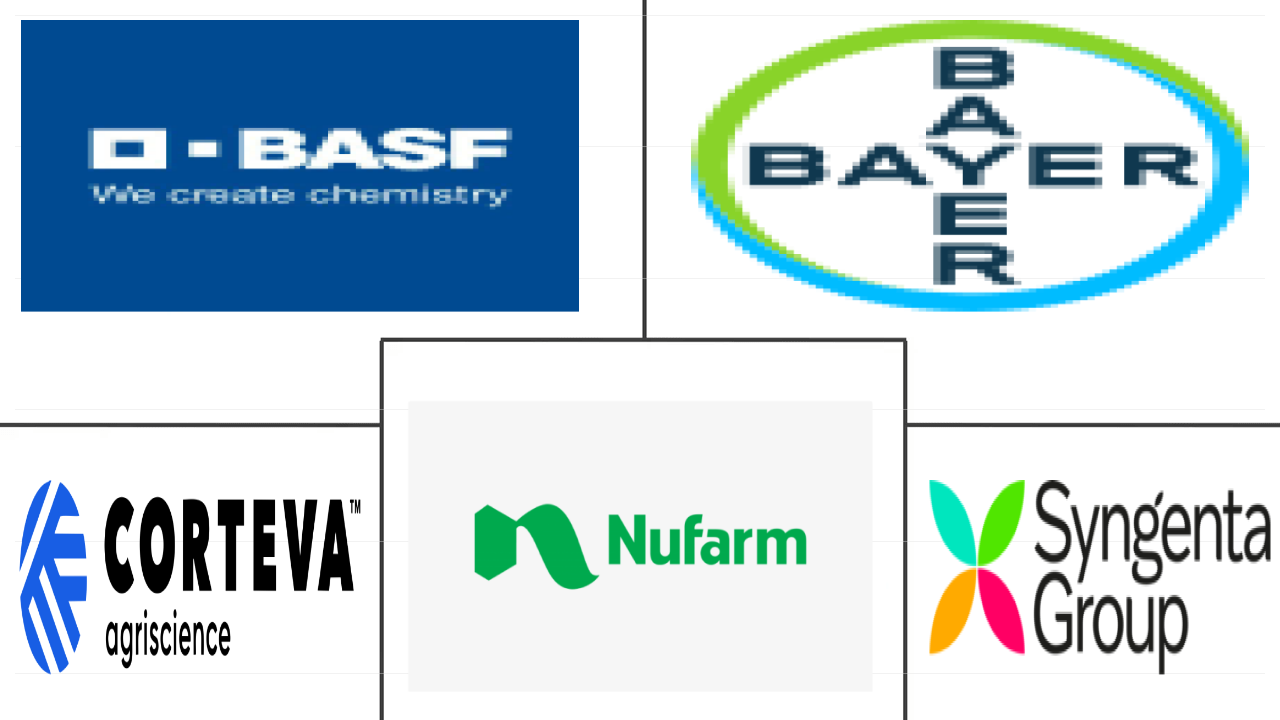Market Size of north america herbicide Industry
|
|
Study Period | 2017 - 2029 |
|
|
Market Size (2024) | USD 12.79 Billion |
|
|
Market Size (2029) | USD 16.36 Billion |
|
|
Largest Share by Application Mode | Soil Treatment |
|
|
CAGR (2024 - 2029) | 5.05 % |
|
|
Largest Share by Country | United States |
Major Players |
||

|
||
|
*Disclaimer: Major Players sorted in no particular order |
North America Herbicide Market Analysis
The North America Herbicide Market size is estimated at 12.79 billion USD in 2024, and is expected to reach 16.36 billion USD by 2029, growing at a CAGR of 5.05% during the forecast period (2024-2029).
12.79 Billion
Market Size in 2024 (USD)
16.36 Billion
Market Size in 2029 (USD)
6.97 %
CAGR (2017-2023)
5.05 %
CAGR (2024-2029)
Largest Segment by Application Mode
48.89 %
value share, Soil Treatment, 2023
Soil treatment of herbicides is a great addition to any weed management program. By reducing weed pressure early on, crops can get off to a strong start in the cropping season.
Largest Segment by Crop Type
44.25 %
value share, Grains & Cereals, 2023
Increased demand for cereals and a rise in weed infestations such as johnsongrass, nutsedge, bermudagrass, and dandelion drive the herbicide market.
Largest Segment By Country
85.46 %
value share, United States, 2023
Yield losses due to weeds are a major threat to crop production in the country. As per the Weed Science Society of America, yield loss due to weeds was estimated to be 25.6%.
Leading Market Player 1
20.83 %
market share, Bayer AG, 2022

Bayer has partnered with Oerth Bio to develop next-generation crop protection products based on Oerth Bio's innovative protein degradation technology.
Leading Market Player 2
15.86 %
market share, Syngenta Group, 2022

The company invests more than USD 1.3 billion annually in global R&D to develop advanced, innovative technologies and products to address farmers' crop protection challenges.
Soil applications dominate the North American herbicide market
- Weeds are a major contributor to yield loss and reduced quality in an agricultural system. They compete with the crop for light, water, and nutrients. Weeds can also harm crop plants by acting as reservoirs for destructive insect vectors that move pathogens from plant to plant. Using herbicides is the most effective weed management tool, as they are cheaper, require less labor, and save more time than other measures. Several herbicide application techniques can be used to control various weeds.
- Soil application dominated the North American herbicide market, accounting for a market share of 48.9% in 2022. Mainly, pre-emergence herbicides can be applied through soil treatment. By reducing weed pressures early on, crops can get off to a strong start in the cropping season. With different active ingredients and application timings, soil-active herbicides can help tackle troublesome resistant weeds and slow down the development of herbicide resistance. Among the pre-emergence herbicides, the three most commonly used and the most effective through soil treatment are oxadiazon, pendimethalin, and pretilachlor.
- Foliar application is the second most used method to apply herbicides in North America, accounting for a market share of 29.7% in the year 2022. Post-emergence herbicides will be applied through this method. A post-emergence herbicide must move from the leaf surface and reach the target site to be effective. As herbicide is applied to photosynthesize foliage actively, the leaves take up the chemical and either directly impact the leaf tissue or translocate the herbicide to other parts of the plants. The foliar segment is expected to record significant growth during the forecast period.
The United States dominated the market due to increased yield losses because of weed infestation
- Weeds are a major biotic constraint to production in different cropping systems of North America. Yield losses in crops due to weeds depend on several factors, such as weed emergence time, weed density, the type of weed, and the type of crops. If left uncontrolled, weeds can result in 100% yield loss. Herbicides are an integral part of weed control.
- The United States dominated the market, accounting for a market share of 85.5% in 2022. It is one of the world's largest wheat producers and exporters. However, wheat yield losses caused by weeds pose a serious threat to the country's wheat production and farmers' economic prosperity. In 2022, the WSSA's Weed Loss Committee estimated the winter wheat yield loss at approximately 25.6% due to weeds. The WSSA Weed Loss Committee found that the use of herbicides combined with best management practices resulted in a decrease in wheat yield loss from 60% to 20%.
- Canada accounted for 9.0% of the North American herbicide market in 2022. Canola is the major crop grown in the country. Average canola yield losses due to weeds varied by province/state. Alberta had the highest yield losses, estimated at 34.6%, a loss of 72 million bushels, based on the average harvested area and average yield. Saskatchewan had an estimated yield loss of 30.2%, a loss of 86 million bushels. Manitoba's estimated yield loss was 18.1%, resulting in a loss of 19 million bushels. North Dakota had an estimated yield loss of 27.9%, resulting in a loss of 11 million bushels in 2022.
- The increase in weed infestations, which greatly impacts the increasing domestic and international demand, and increasing concerns for food security are driving the market. The market is anticipated to witness a CAGR of 4.9% during the forecast period (2023-2029).
North America Herbicide Industry Segmentation
Chemigation, Foliar, Fumigation, Soil Treatment are covered as segments by Application Mode. Commercial Crops, Fruits & Vegetables, Grains & Cereals, Pulses & Oilseeds, Turf & Ornamental are covered as segments by Crop Type. Canada, Mexico, United States are covered as segments by Country.
- Weeds are a major contributor to yield loss and reduced quality in an agricultural system. They compete with the crop for light, water, and nutrients. Weeds can also harm crop plants by acting as reservoirs for destructive insect vectors that move pathogens from plant to plant. Using herbicides is the most effective weed management tool, as they are cheaper, require less labor, and save more time than other measures. Several herbicide application techniques can be used to control various weeds.
- Soil application dominated the North American herbicide market, accounting for a market share of 48.9% in 2022. Mainly, pre-emergence herbicides can be applied through soil treatment. By reducing weed pressures early on, crops can get off to a strong start in the cropping season. With different active ingredients and application timings, soil-active herbicides can help tackle troublesome resistant weeds and slow down the development of herbicide resistance. Among the pre-emergence herbicides, the three most commonly used and the most effective through soil treatment are oxadiazon, pendimethalin, and pretilachlor.
- Foliar application is the second most used method to apply herbicides in North America, accounting for a market share of 29.7% in the year 2022. Post-emergence herbicides will be applied through this method. A post-emergence herbicide must move from the leaf surface and reach the target site to be effective. As herbicide is applied to photosynthesize foliage actively, the leaves take up the chemical and either directly impact the leaf tissue or translocate the herbicide to other parts of the plants. The foliar segment is expected to record significant growth during the forecast period.
| Application Mode | |
| Chemigation | |
| Foliar | |
| Fumigation | |
| Soil Treatment |
| Crop Type | |
| Commercial Crops | |
| Fruits & Vegetables | |
| Grains & Cereals | |
| Pulses & Oilseeds | |
| Turf & Ornamental |
| Country | |
| Canada | |
| Mexico | |
| United States | |
| Rest of North America |
North America Herbicide Market Size Summary
The North America herbicide market is experiencing steady growth, driven by the critical need for effective weed management in agricultural systems. Weeds significantly impact crop yield and quality by competing for essential resources and acting as vectors for pests. Herbicides are the preferred solution due to their cost-effectiveness, labor efficiency, and time-saving benefits compared to other weed control methods. The market is characterized by various application techniques, with soil application leading the segment, particularly for pre-emergence herbicides. These herbicides are crucial for early-season weed control, helping to establish strong crop growth. Foliar application, used for post-emergence herbicides, is also significant and expected to grow. The United States dominates the market, largely due to its extensive wheat production, while Canada contributes with its canola crops. The increasing demand for food security and the rise in weed infestations are key factors propelling market expansion.
The market is also influenced by the emergence of herbicide-resistant weeds, prompting farmers to use higher quantities or multiple types of herbicides to maintain effectiveness. Conservation tillage practices have increased reliance on herbicides, as they offer environmental benefits but require robust weed control solutions. Advancements in herbicide formulation technologies and the adoption of genetically modified crops have further facilitated targeted herbicide application, enhancing crop yield potential. Commonly used herbicides in the region include atrazine, paraquat, and glyphosate, each playing a vital role in managing weed growth across various crops. The market is fairly consolidated, with major players like BASF SE, Bayer AG, Corteva Agriscience, Nufarm Ltd, and Syngenta Group leading the industry. Recent product launches and partnerships aim to address weed resistance and improve crop protection technologies, indicating ongoing innovation and adaptation within the market.
North America Herbicide Market Size - Table of Contents
-
1. MARKET SEGMENTATION (includes market size in Value in USD and Volume, Forecasts up to 2029 and analysis of growth prospects)
-
1.1 Application Mode
-
1.1.1 Chemigation
-
1.1.2 Foliar
-
1.1.3 Fumigation
-
1.1.4 Soil Treatment
-
-
1.2 Crop Type
-
1.2.1 Commercial Crops
-
1.2.2 Fruits & Vegetables
-
1.2.3 Grains & Cereals
-
1.2.4 Pulses & Oilseeds
-
1.2.5 Turf & Ornamental
-
-
1.3 Country
-
1.3.1 Canada
-
1.3.2 Mexico
-
1.3.3 United States
-
1.3.4 Rest of North America
-
-
North America Herbicide Market Size FAQs
How big is the North America Herbicide Market?
The North America Herbicide Market size is expected to reach USD 12.79 billion in 2024 and grow at a CAGR of 5.05% to reach USD 16.36 billion by 2029.
What is the current North America Herbicide Market size?
In 2024, the North America Herbicide Market size is expected to reach USD 12.79 billion.

